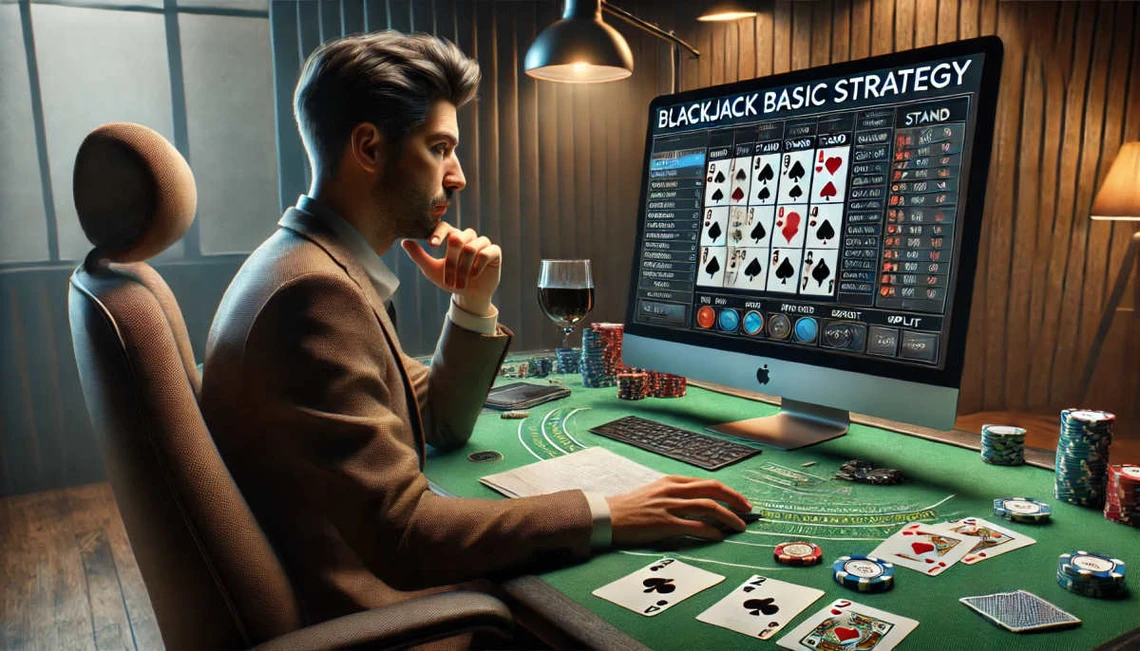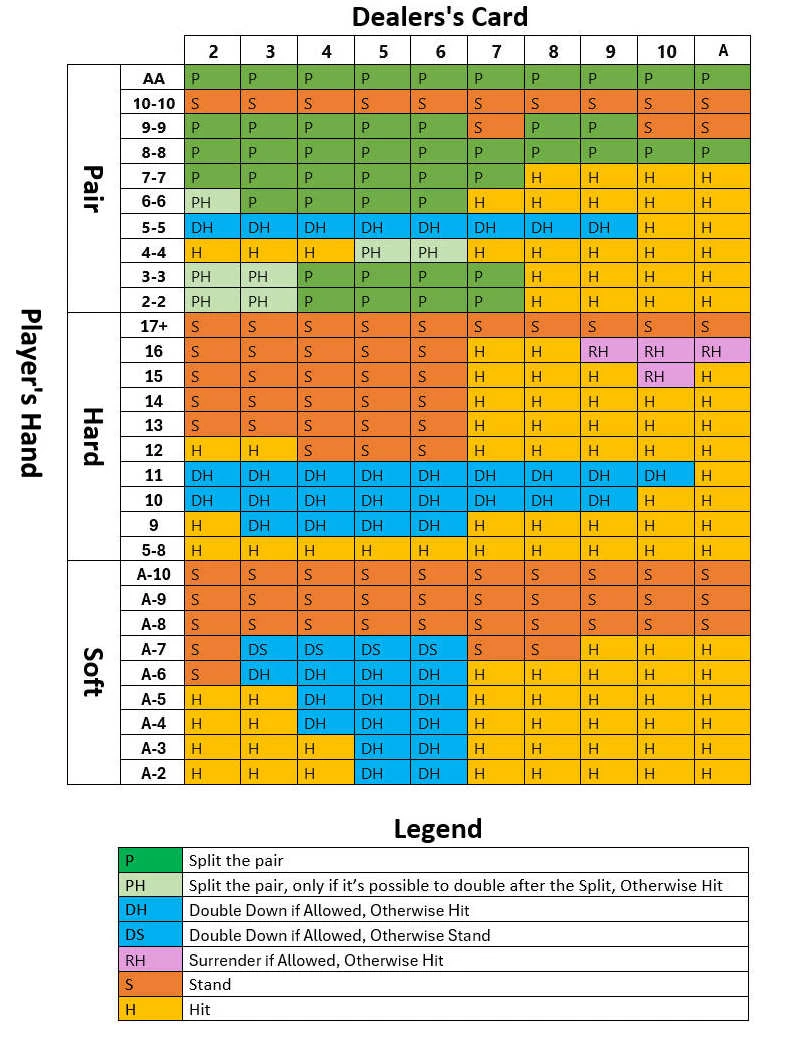
Blackjack Basic Strategy

Blackjack is a game where skill and strategy can significantly influence the outcome. For those looking to improve their odds, mastering blackjack basic strategy is essential. While our previous article delved into the fundamental rules of blackjack, this guide focuses on using basic strategy to minimize the house edge and make informed decisions, particularly for beginners and occasional players, as more experienced players generally already know these rules.
Basic strategy is a mathematical approach in blackjack that guides optimal decisions, reducing the house edge and increasing winning chances in both physical and online casinos. This article offers practical advice on these strategies for all players.
Understanding Blackjack Basic Strategy
Understanding the foundation of blackjack basic strategy is essential for any player looking to improve their game and reduce the house edge.
What is a basic Blackjack strategy?
It’s a mathematically driven guide that helps players decide when to hit, stand, double down, or split, based on their hand and the dealer's upcard. Developed through computer simulations, this strategy aims to reduce player losses and lower the house edge, offering the best statistical chances of winning, whether in a physical casino or online.
Core Principles:
The core principles of blackjack basic strategy revolve around making the best possible decision in any given situation. Here are the key actions:
- Hit or Stand: When to hit (take another card) or stand (keep your current hand) depends on your total and the dealer's upcard. For example, players should always hit on a hard total of 8 or less and stand on 17 or more.
- Double Down: This move is advisable when you have a strong hand, such as 10 or 11, and the dealer's upcard is weaker. Doubling down allows you to double your initial bet in exchange for committing to stand after receiving one more card.
- Splitting: Splitting is recommended when you are dealt a pair, and it can convert a weak hand into two potential winners. For instance, always split aces and eights, but never split tens
Always:
- Always split Aces and 8s: Splitting Aces gives you a strong chance of forming two solid hands, while splitting 8s helps avoid the weak total of 16.
- Always double down on 11: When you have a total of 11, doubling down is usually favorable since you're likely to get a strong hand.
- Always stand on 17 or higher: With a hand total of 17 or more, standing is the safest choice, as hitting risks going bust.
- Always hit on a hard 8 or lower: With a total of 8 or less, hitting is necessary to improve your hand's chances.
- Always hit on a soft 17 or lower: With an Ace counted as 11 (soft hand), hitting gives a good chance of improving your hand without going bust.
Never:
- Never split 10s: A total of 20 is very strong, so splitting would likely weaken your position.
- Never take insurance: Insurance is a side bet with a high house edge, which usually isn’t worth the risk.
- Never stand on 12 against a dealer's 2 or 3: In these cases, hitting is more likely to improve your hand or reduce losses.
- Never hit on a hard 17 or higher: With a hard hand of 17 or more, hitting risks busting, so it's safer to stand.
- Never double down on a hard 12-16: These totals are too weak to justify the risk of doubling your bet.
The Basic Strategy Chart
The basic strategy chart is an essential tool for blackjack players, offering a quick reference for the optimal action in any given situation. Below is an image of the table, which categorizes decisions based on the type of hand and the dealer’s upcard.

See our dedicated article for all the blackjack charts.
Explanation:
The basic strategy chart is divided into three main sections: hard totals, soft totals, and pairs.
- Hard Totals: These are hands without an Ace, or where the Ace counts as 1. The chart shows whether to hit, stand, double down, or surrender based on the dealer’s upcard.
- Soft Totals: These involve hands where the Ace counts as 11. Soft hands are more flexible, and the chart will often recommend doubling down in situations where the potential for a strong hand exists.
- Pairs: When dealt a pair, the chart provides guidance on whether to split the hand into two separate hands.
If you don't know the difference between these types of hands, read our article on hard and soft hands first.
Examples:
- Consider a scenario where you have a hard total of 16 and the dealer shows a 10. The chart suggests hitting because the chances of improving your hand outweigh the risk of busting.
- Another example is when you have a pair of 8s against a dealer’s 7; the chart advises splitting to increase your chances of winning one or both hands
Importance of Memorization:
Memorizing the basic strategy chart allows for quicker and more confident decision-making at the table, especially in fast-paced games. This reduces hesitation and the likelihood of errors, ensuring that you always follow the mathematically optimal strategy. By internalizing the chart, and not using it as a cheat sheet, you can focus more on the game itself rather than constantly referencing external materials
Variations in Blackjack Rules
When playing blackjack, it's important to understand how various casino rules can impact the effectiveness of basic strategy and how you should adapt your approach accordingly.
Impact on Strategy
Different casino rules can significantly influence the effectiveness of basic strategy. Key factors include the number of decks used, whether the dealer stands on soft 17, and the payout ratios for a natural blackjack.
- Number of Decks: The number of decks in play affects the house edge. For example, a single-deck game typically offers better odds than an eight-deck game, which slightly alters the recommended moves on the basic strategy chart. This can affect decisions like when to double down or split.
- Dealer Standing on Soft 17: If the dealer is required to stand on soft 17, it lowers the house edge, making it more favorable for the player. However, if the dealer hits on soft 17, players need to adjust their strategy, often being more conservative with doubling down or standing on marginal hands.
- Payout Ratios: Traditional blackjack offers a 3:2 payout for a natural 21, but some casinos now offer a less favorable 6:5 payout. This change increases the house edge and may lead players to avoid certain tables altogether or adjust their betting strategy to compensate.
Adapting Strategy
To adapt to these rule variations, players must tweak their approach:
- Adjusting for Deck Count: In multi-deck games, players might be more cautious with doubling down, especially with borderline hands like 9 or 10 against a dealer’s strong upcard. In contrast, in single-deck games, they might be more aggressive, taking advantage of the better odds.
- Soft 17 Adjustments: If the dealer hits on soft 17, players should be more conservative with hands like soft 18 (Ace-7), opting to hit or double down more often rather than standing.
- Dealing with Payout Variations: In games with a 6:5 payout on blackjack, it may be wise to either reduce the size of your bets or seek out tables with the traditional 3:2 payout. The lower payout diminishes the value of a natural blackjack, so adjusting your betting strategy is crucial to mitigate this disadvantage.
Tips for Mastering Basic Strategy
Mastering blackjack basic strategy takes dedication and a disciplined approach. Here are some essential tips to help you perfect your game:
- Practice: Regular practice using online simulators, apps, or demo versions of blackjack games helps you internalize the basic strategy, making it second nature during real gameplay.
- Common Mistakes: Deviating from basic strategy based on emotions or hunches often leads to increased losses. Sticking to the chart is crucial for minimizing losses and optimizing your chances of winning.
- Bankroll Management: Effective bankroll management is essential alongside using basic strategy. Setting a budget and adjusting your bet sizes prevents significant financial losses and helps maintain disciplined gameplay.
- Don't trust your intuition : Some players mistakenly believe that intuition can improve on basic strategy in blackjack. However, deviating from the chart based on hunches often leads to poor decisions and increased losses.
A final advice
Mastering blackjack basic strategy is important for any player looking to improve their odds and minimize losses. By learning and consistently applying this mathematically derived approach, you can significantly reduce the house edge and make more informed decisions at the table. Whether you’re a beginner or an experienced player, sticking to basic strategy will enhance your chances of success in the long run.
Try your luck at our best selected casinos to play blackjack.

Author
Content Writer